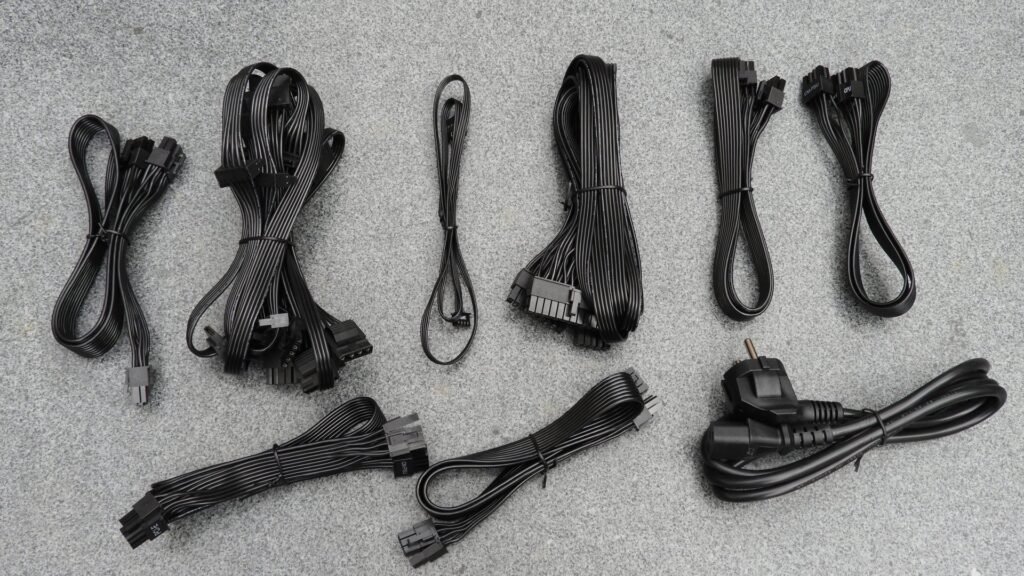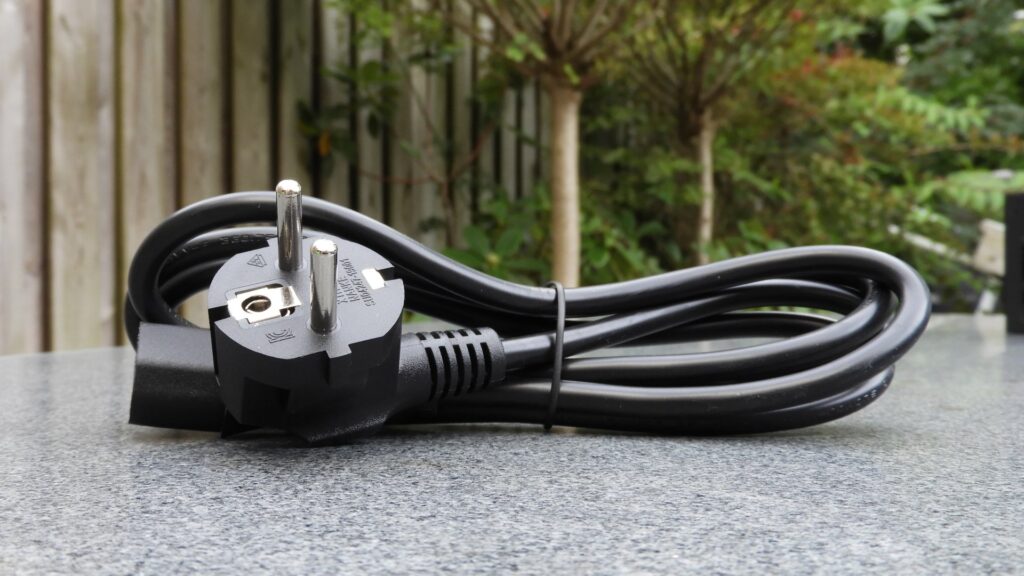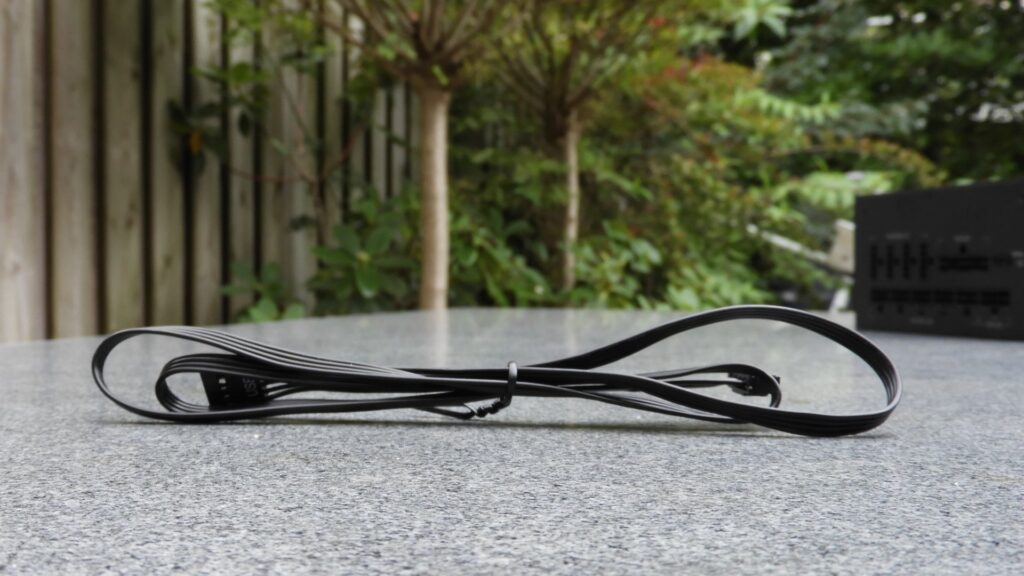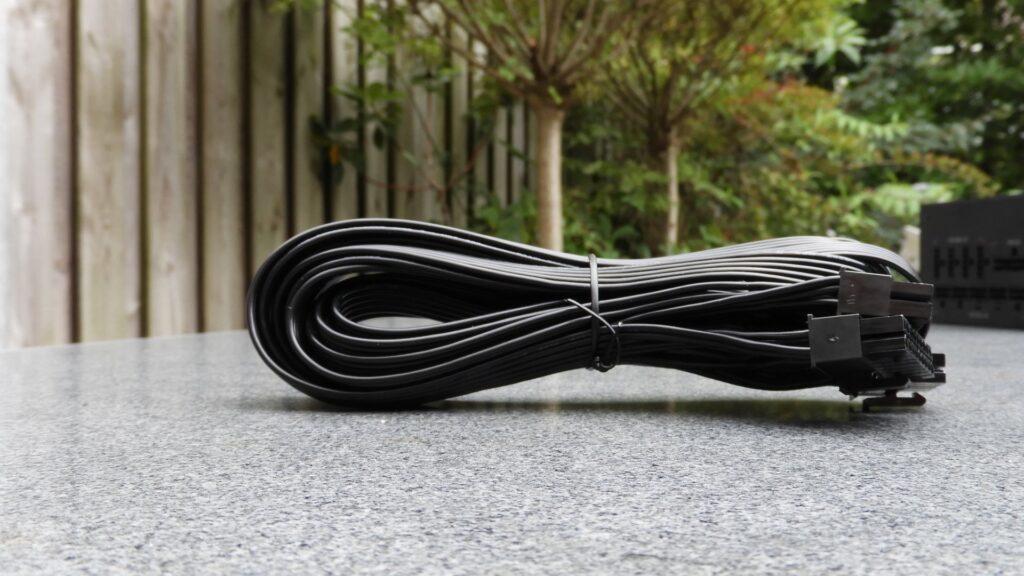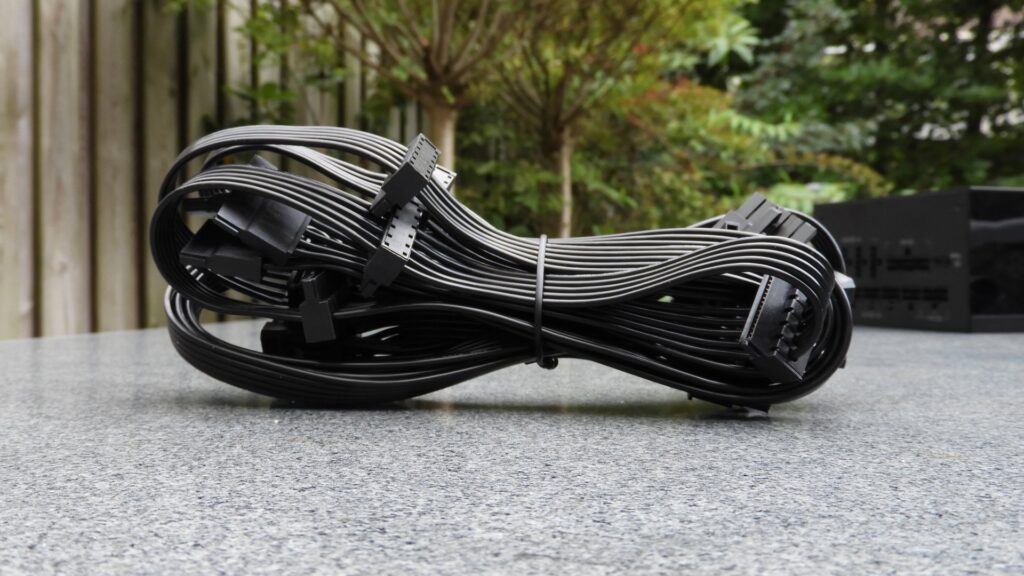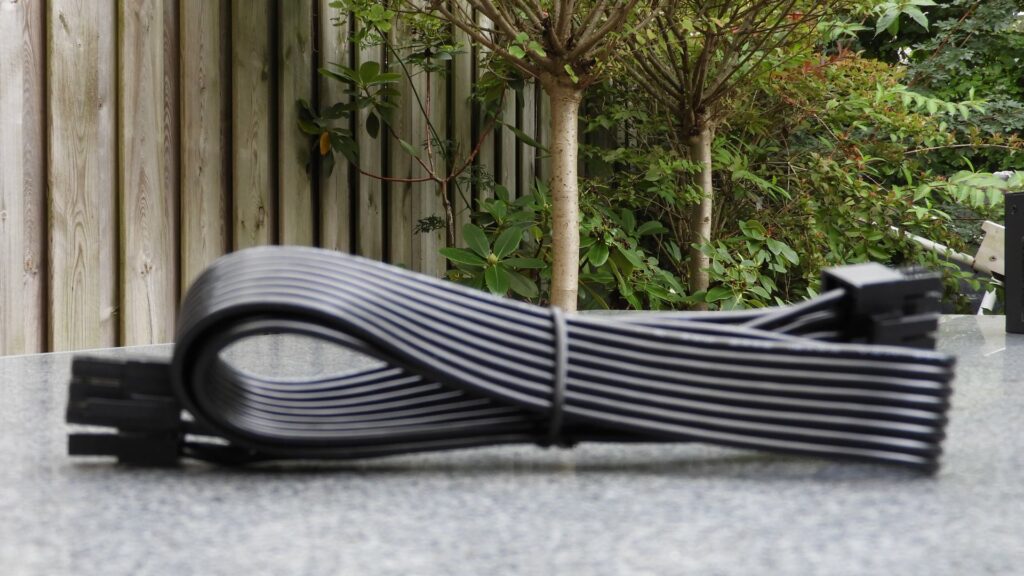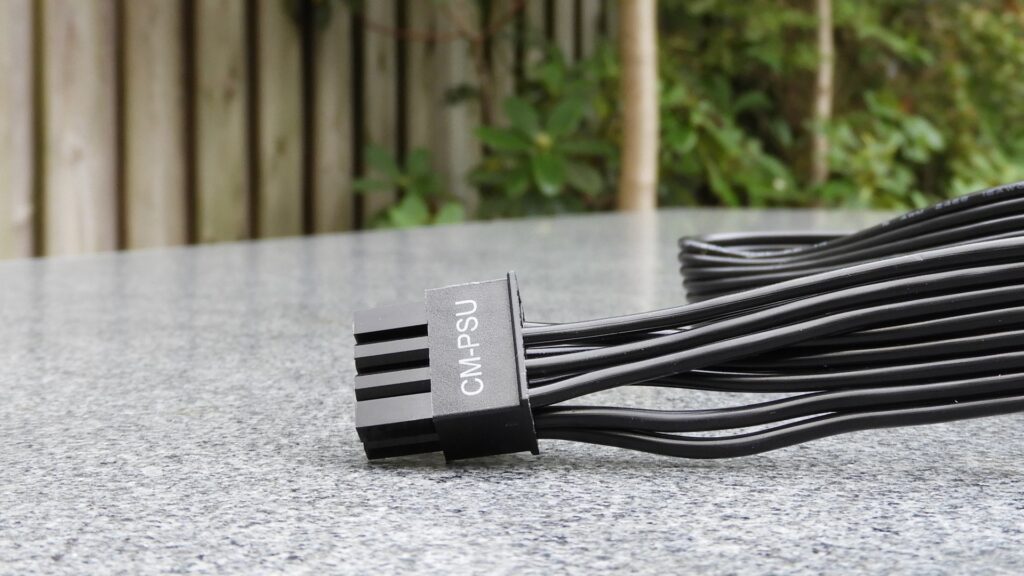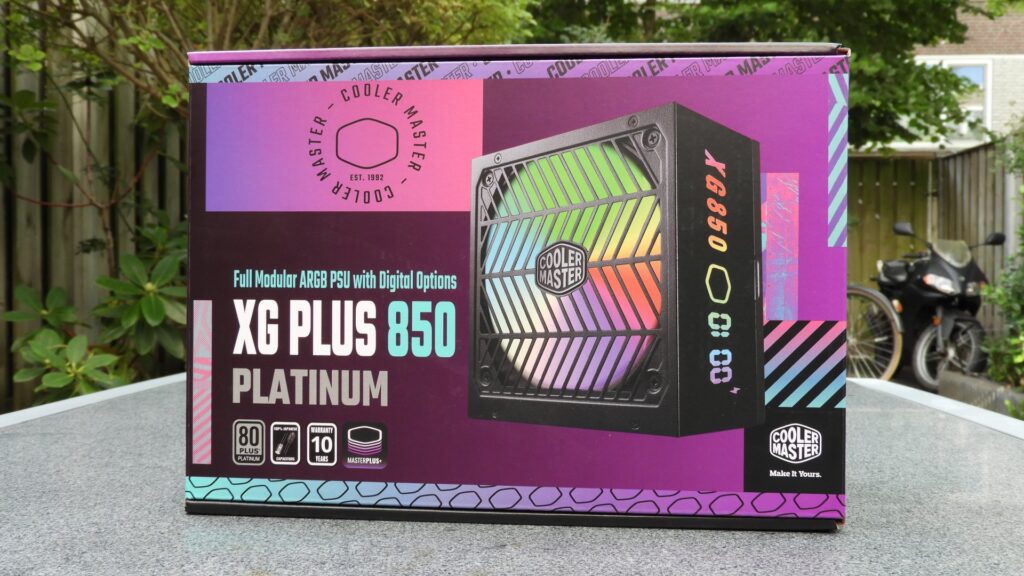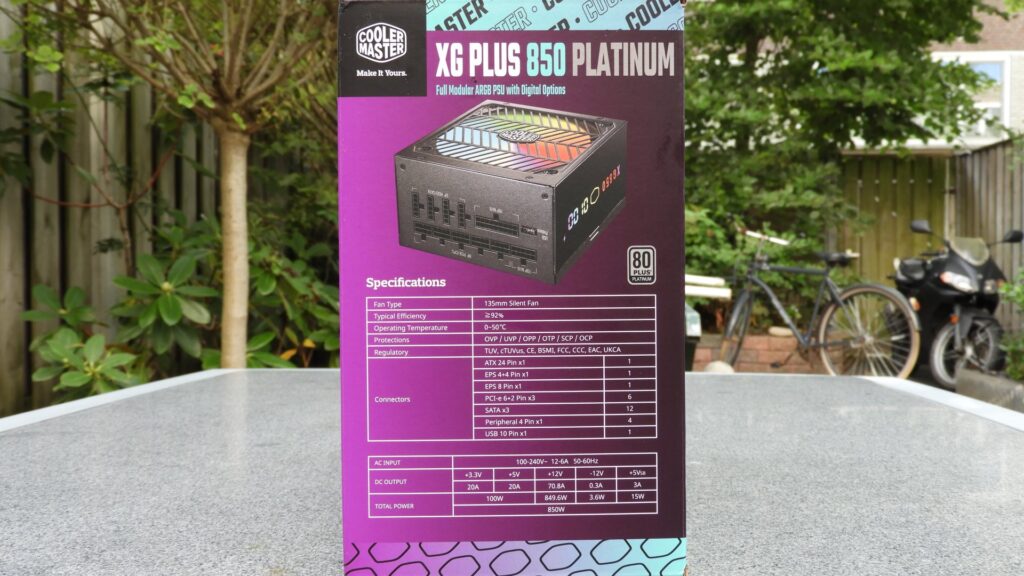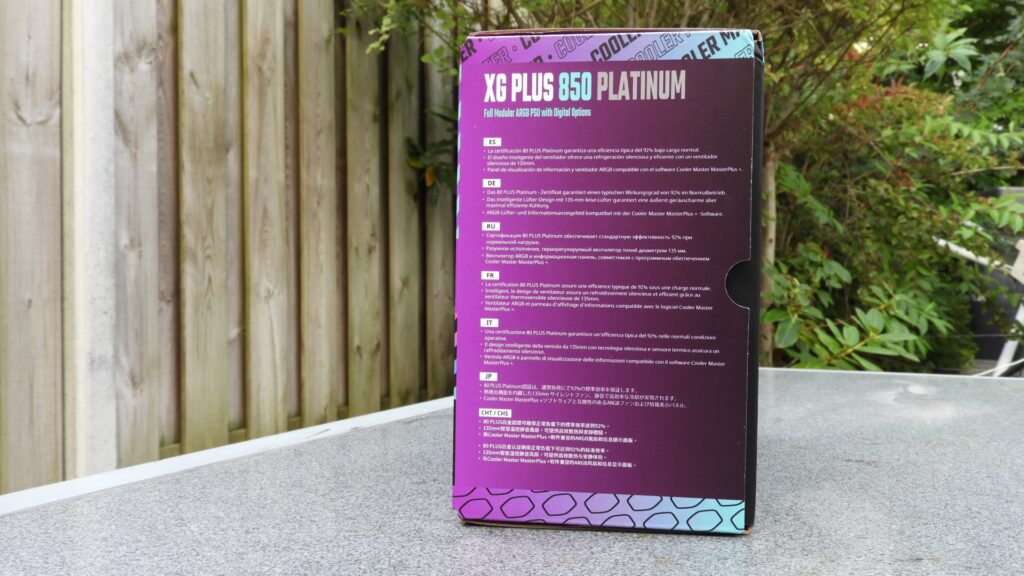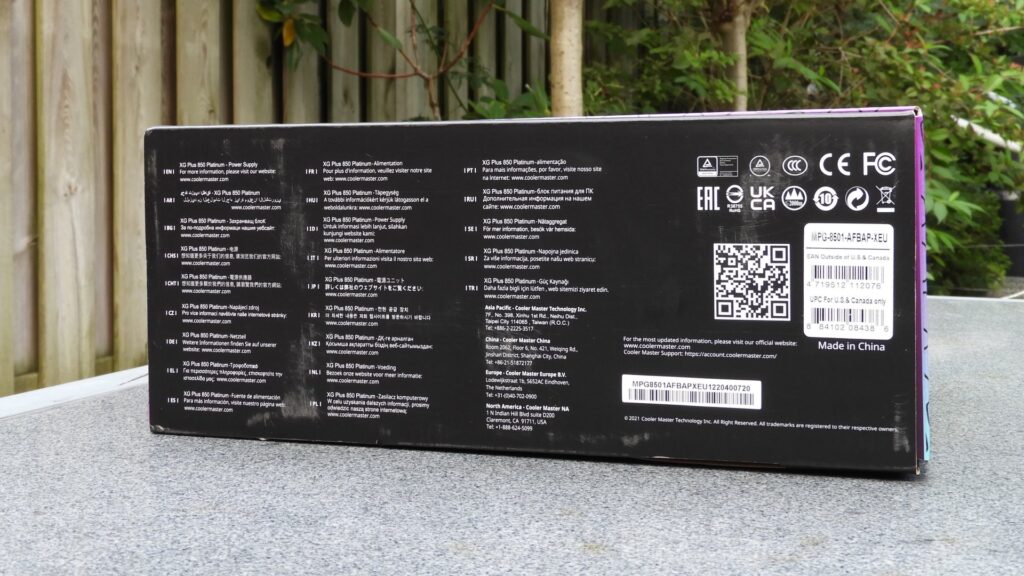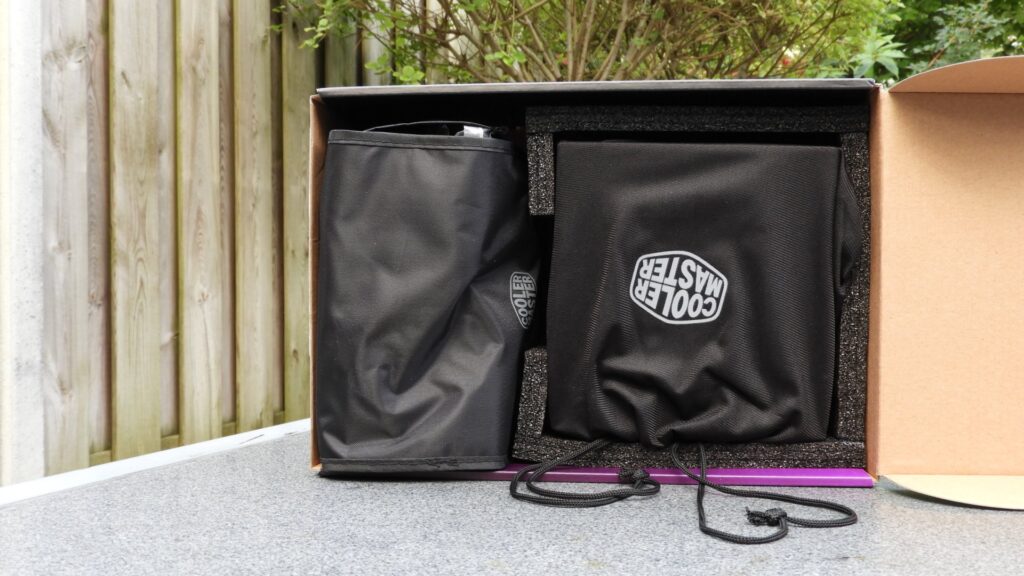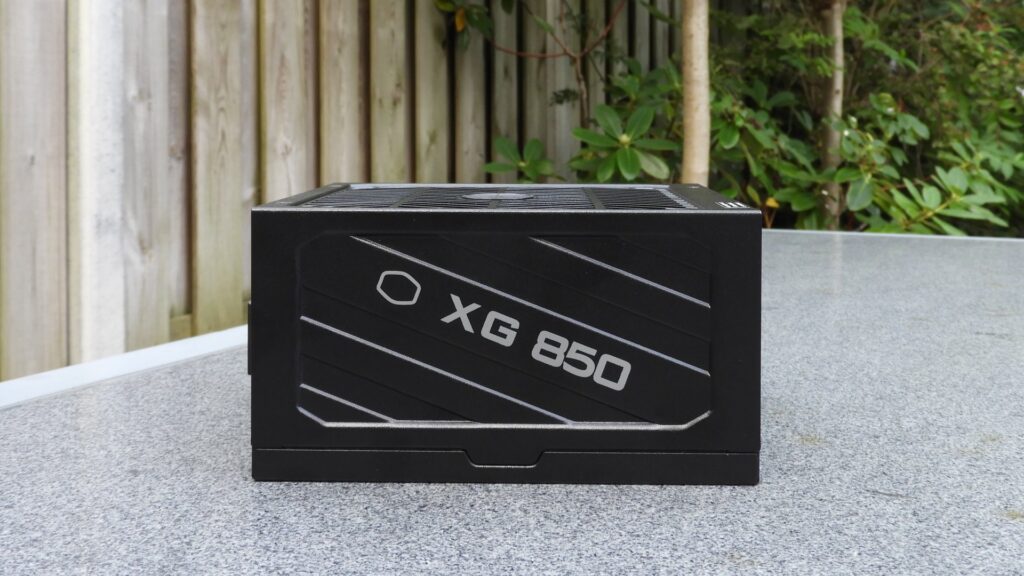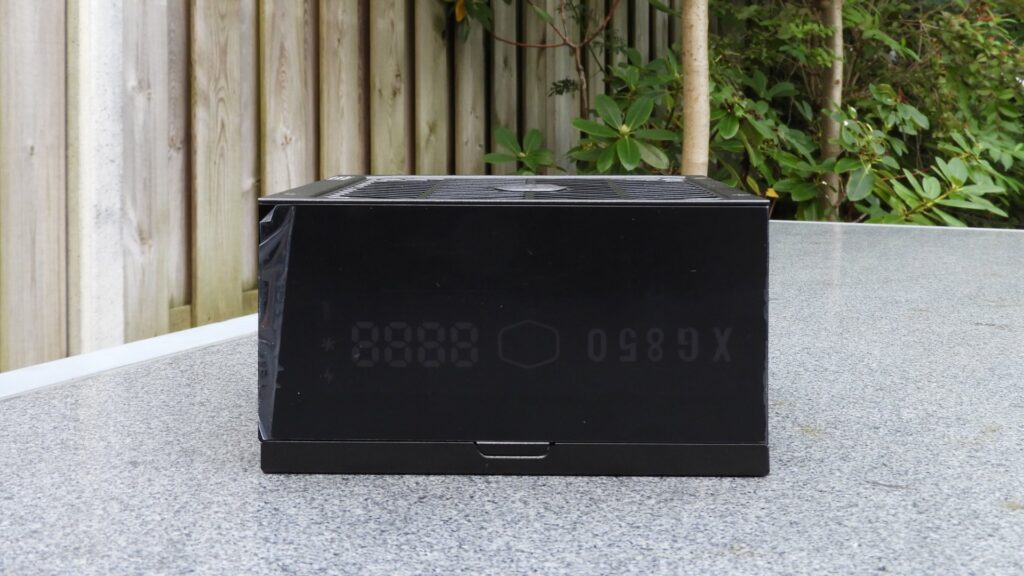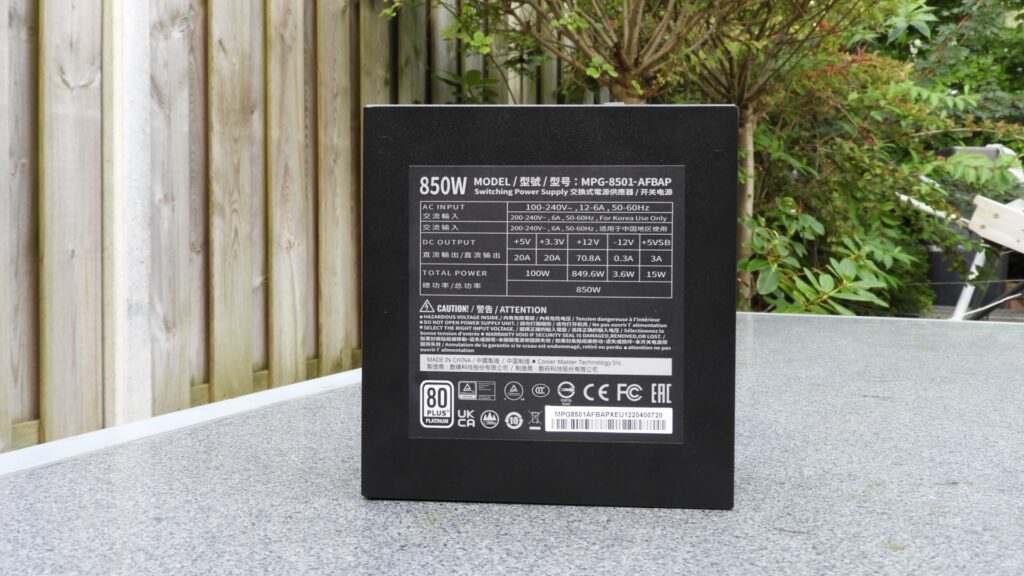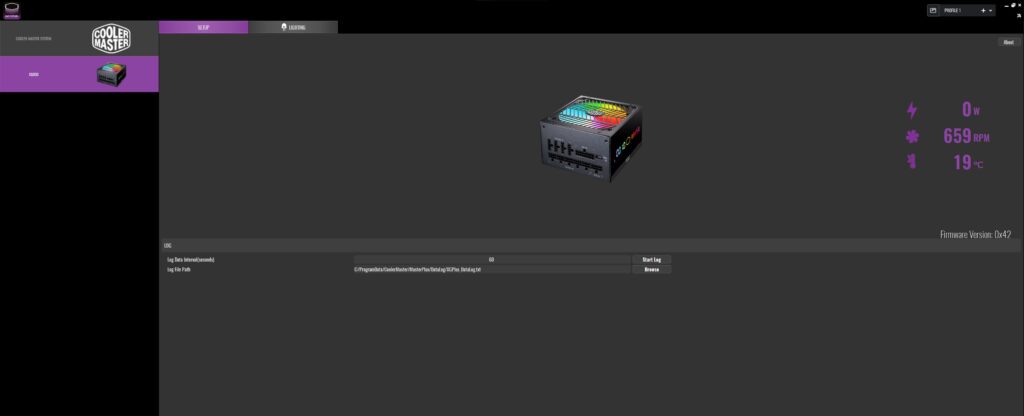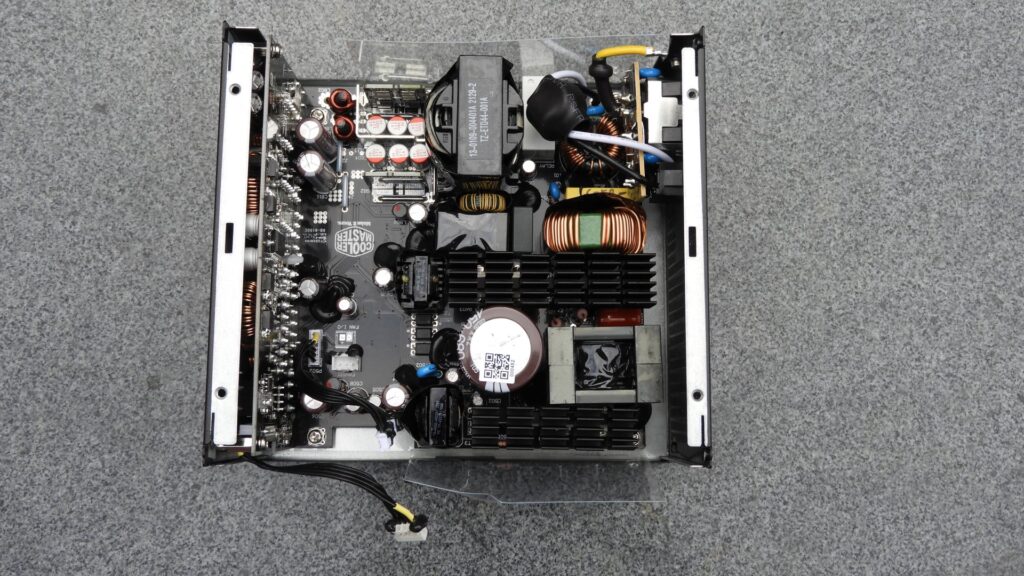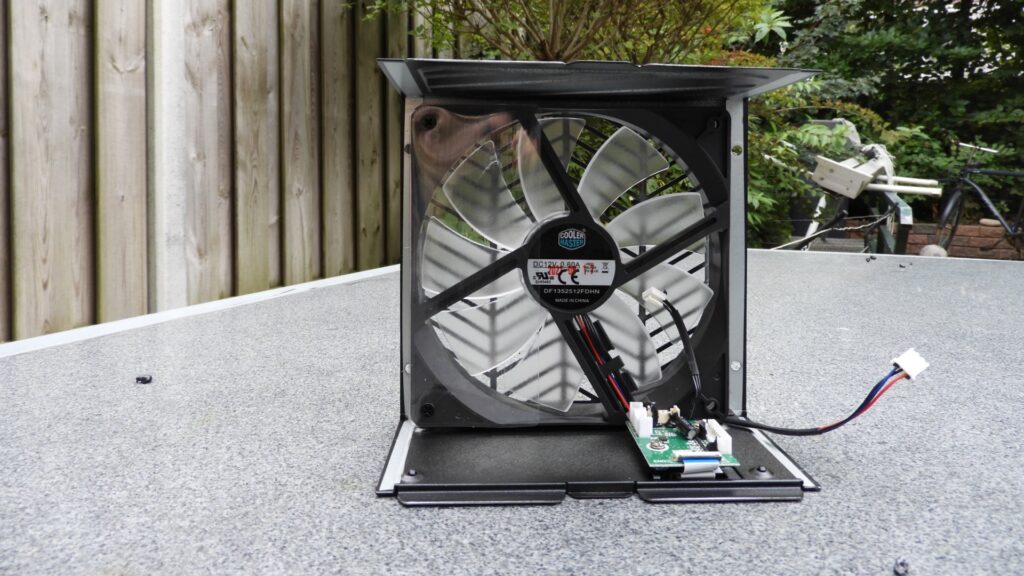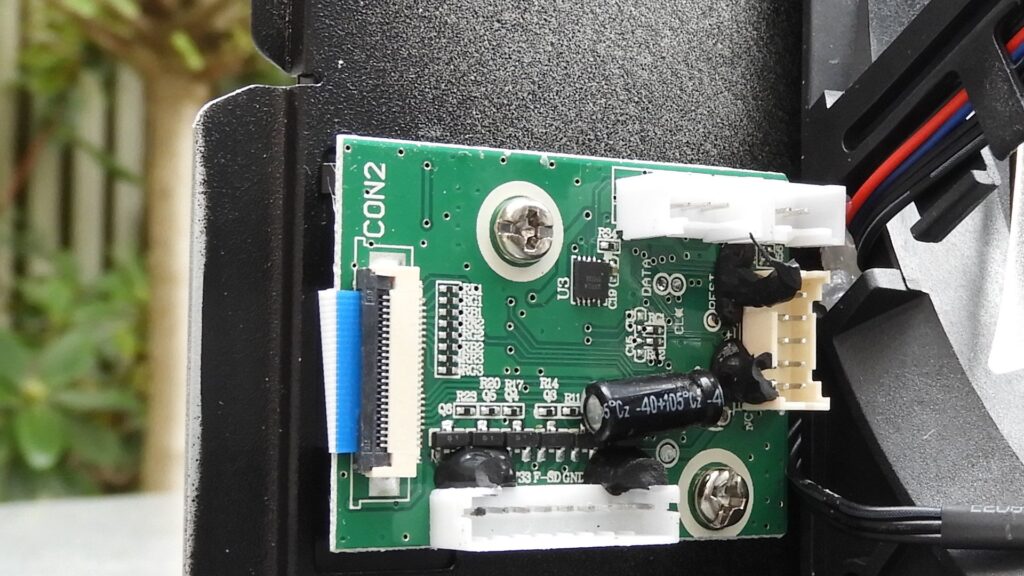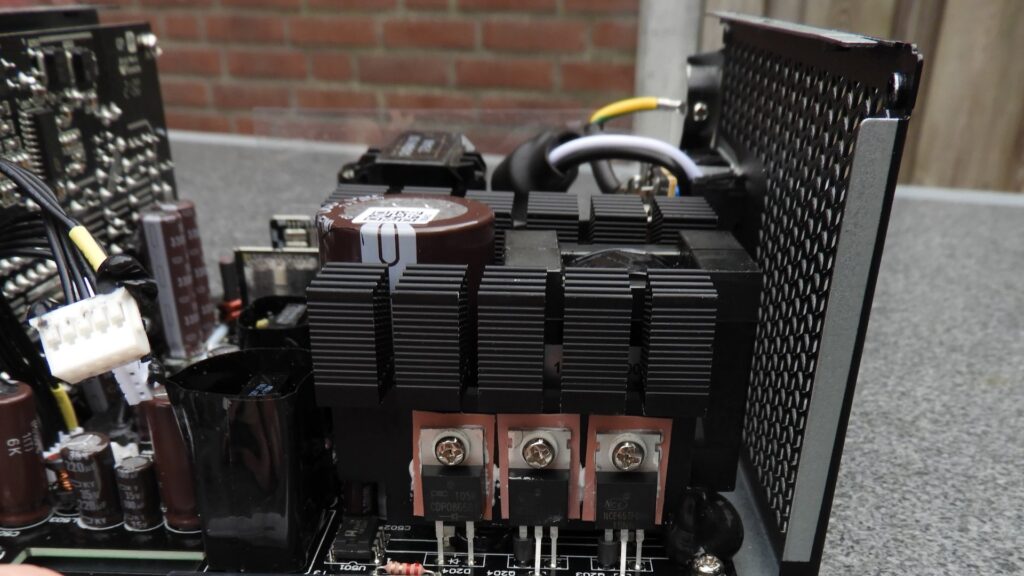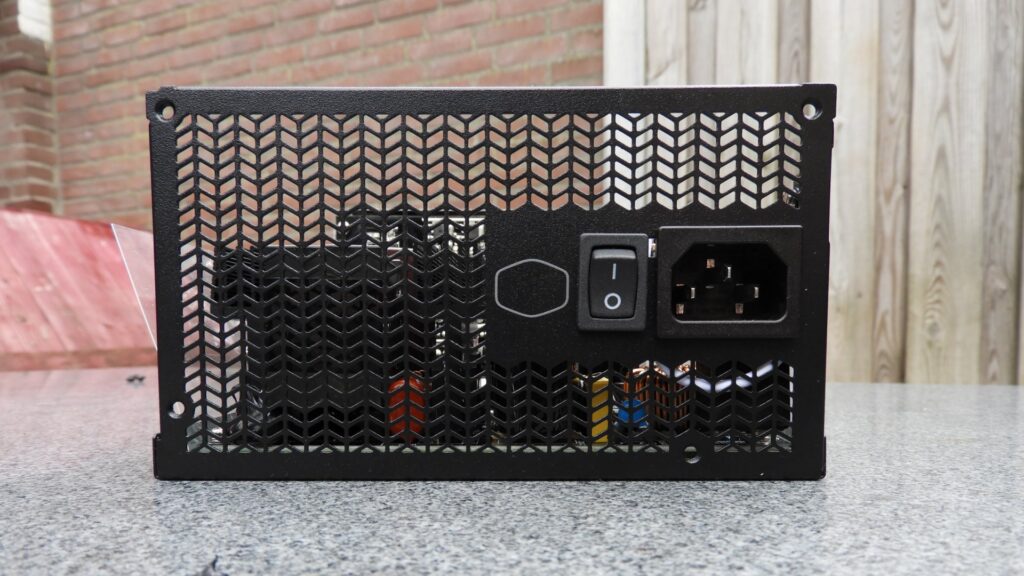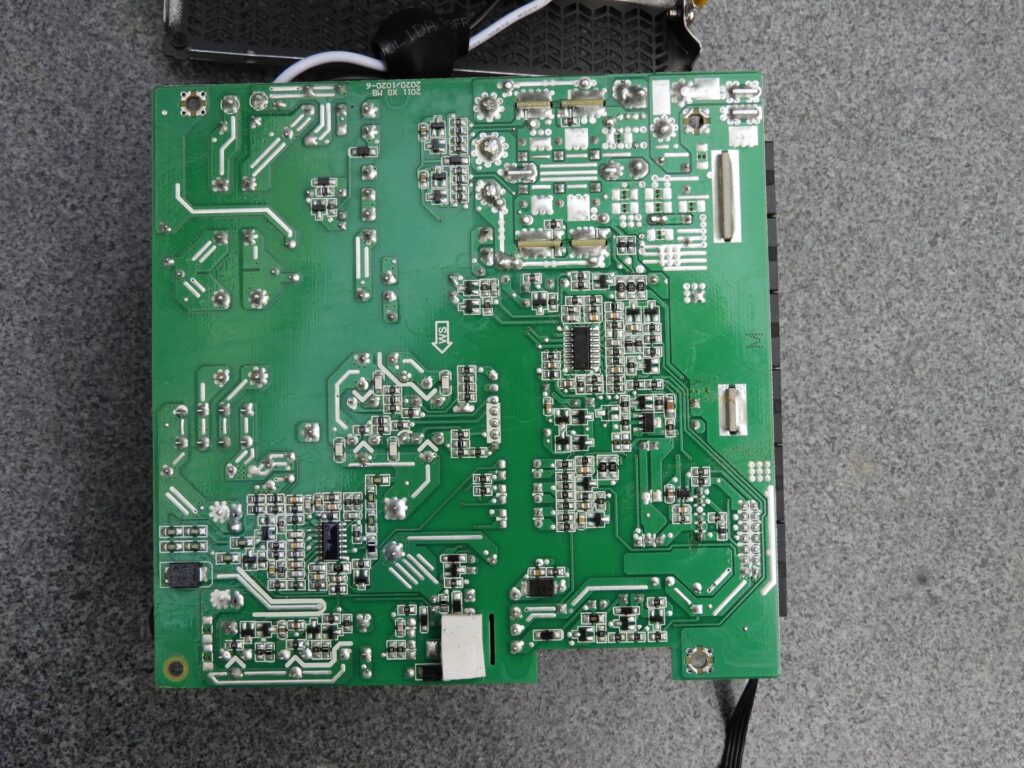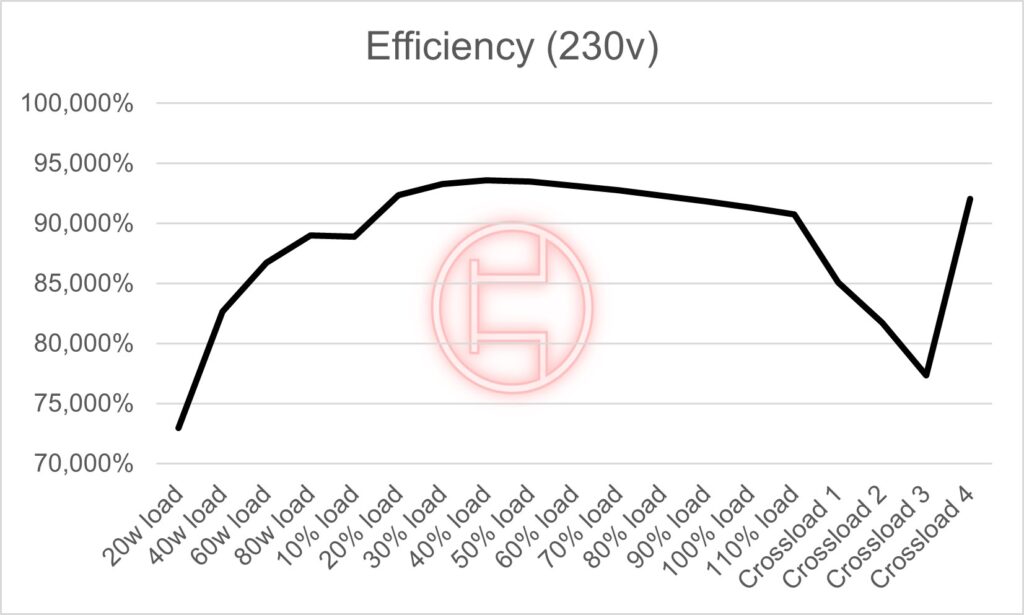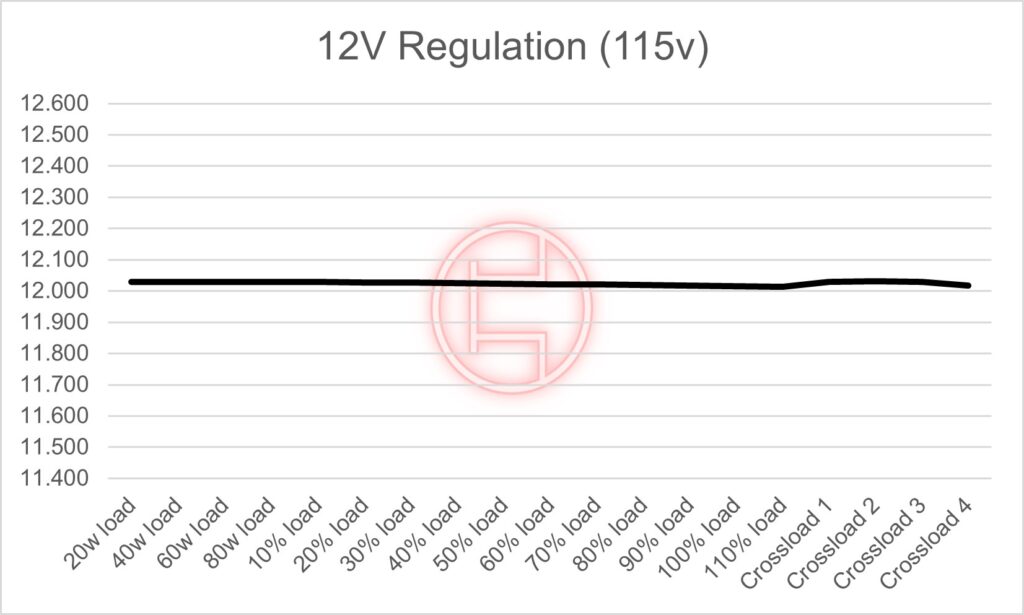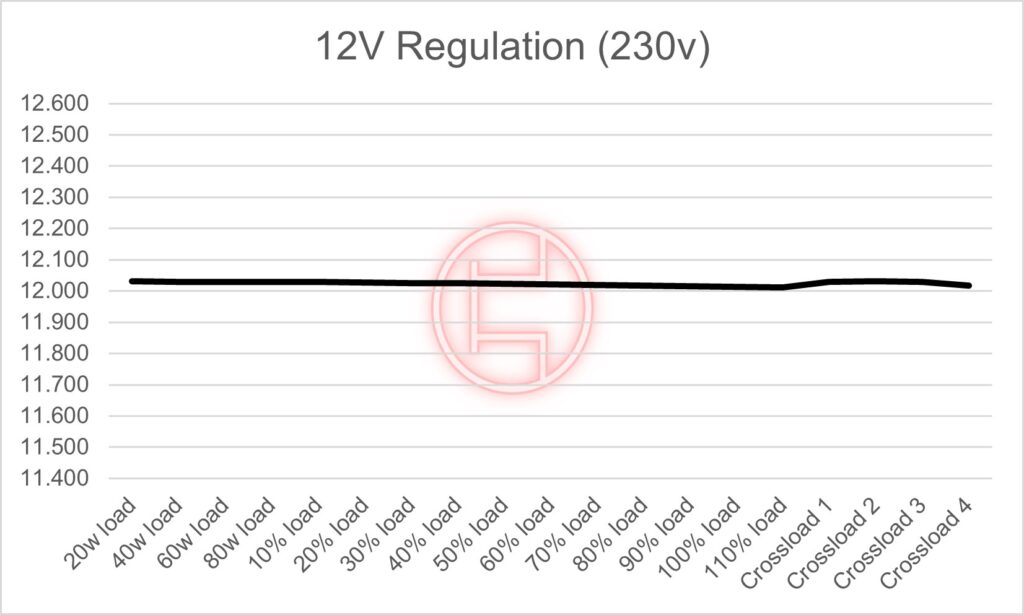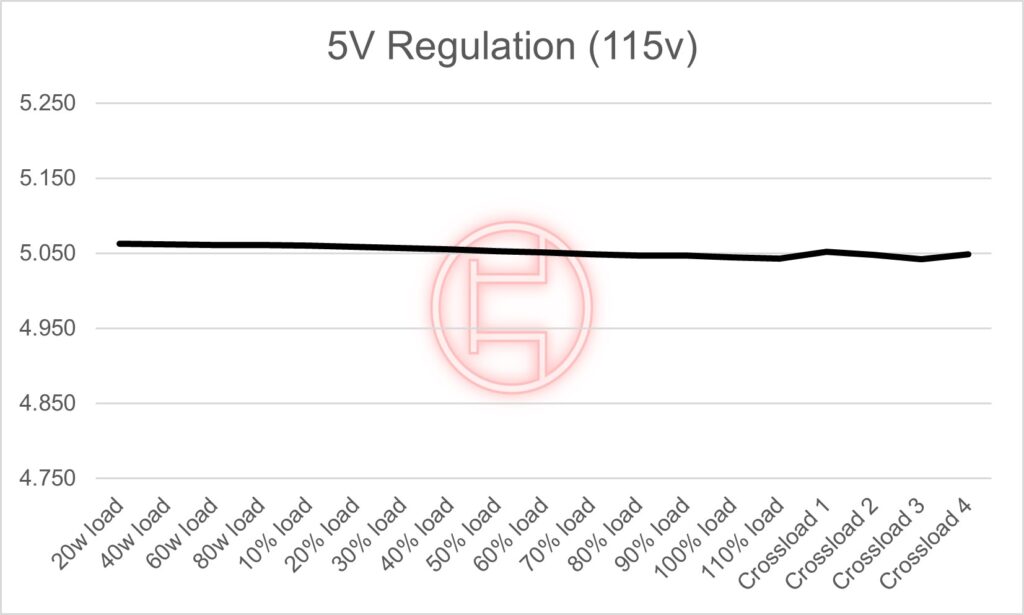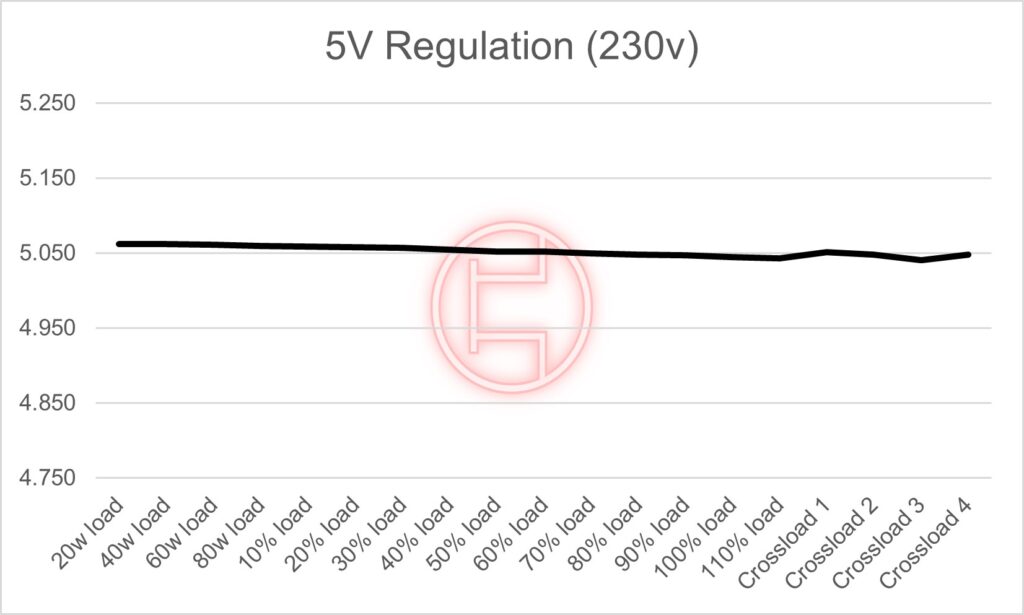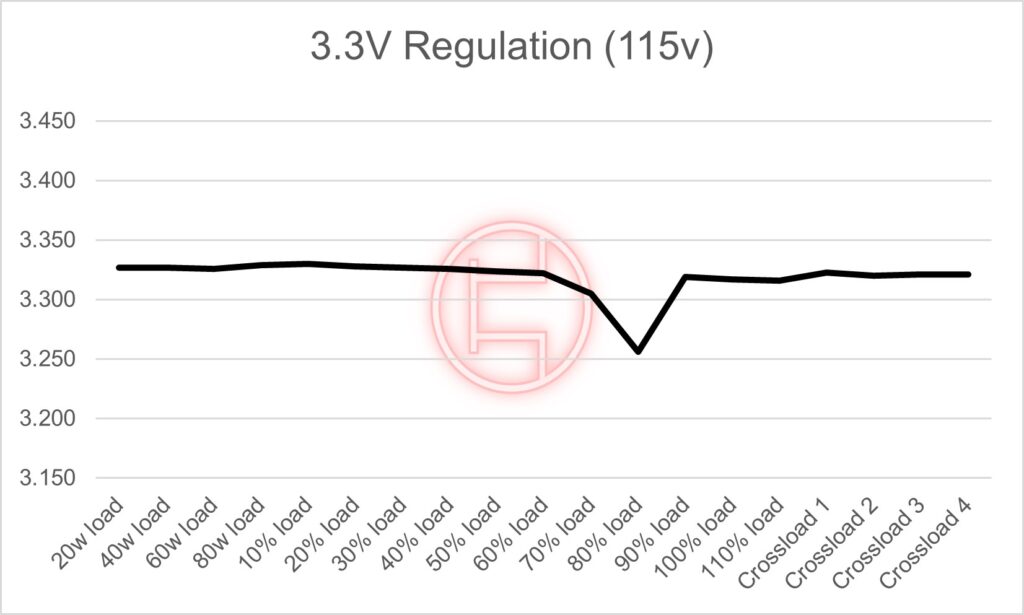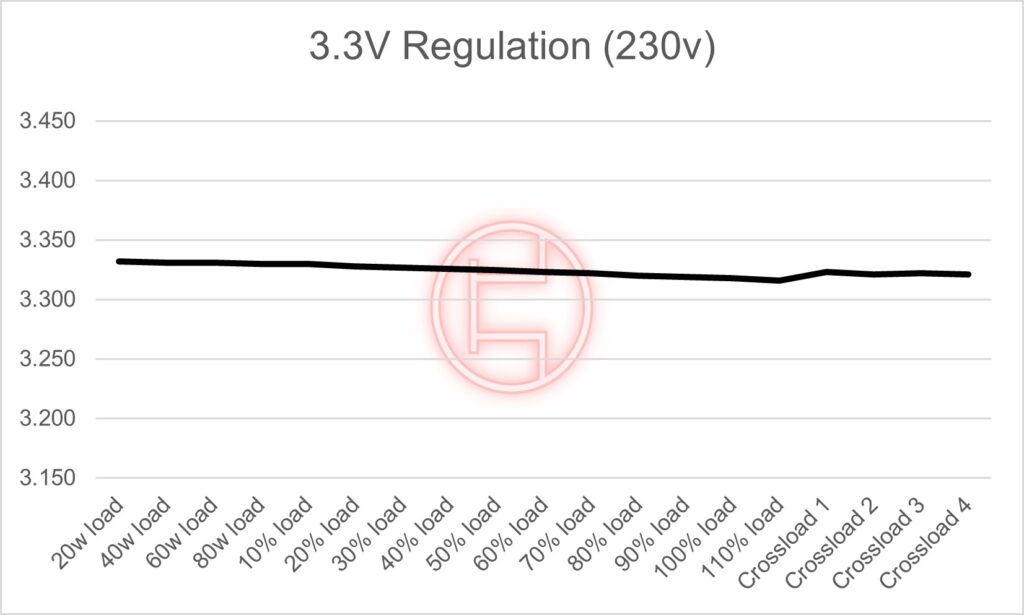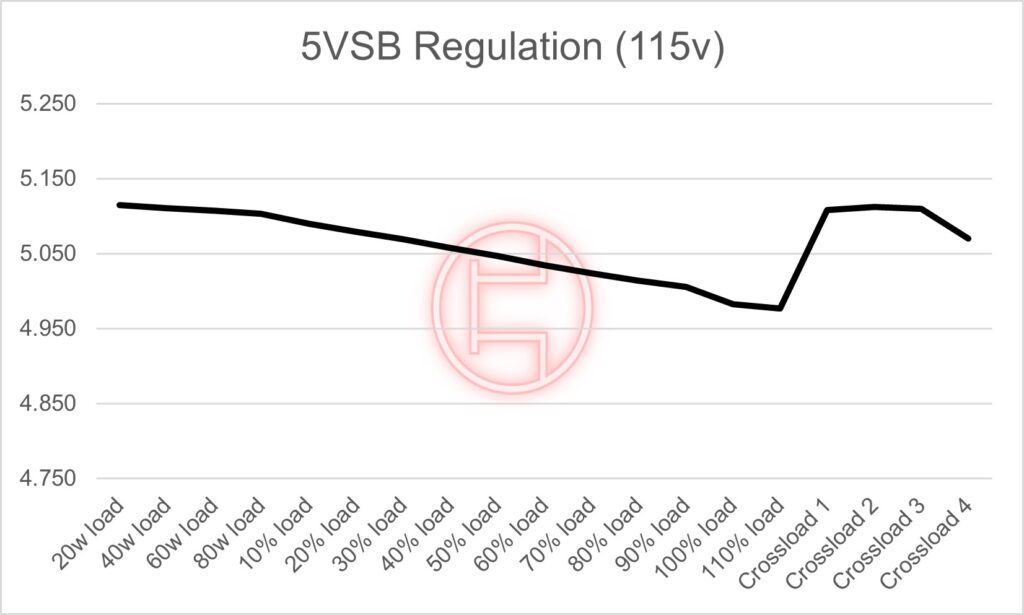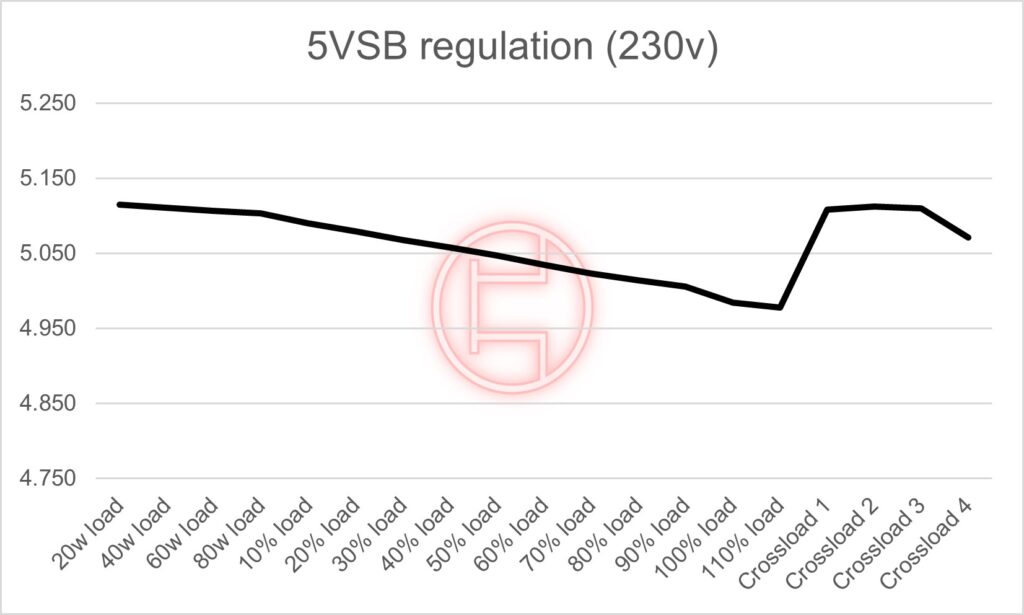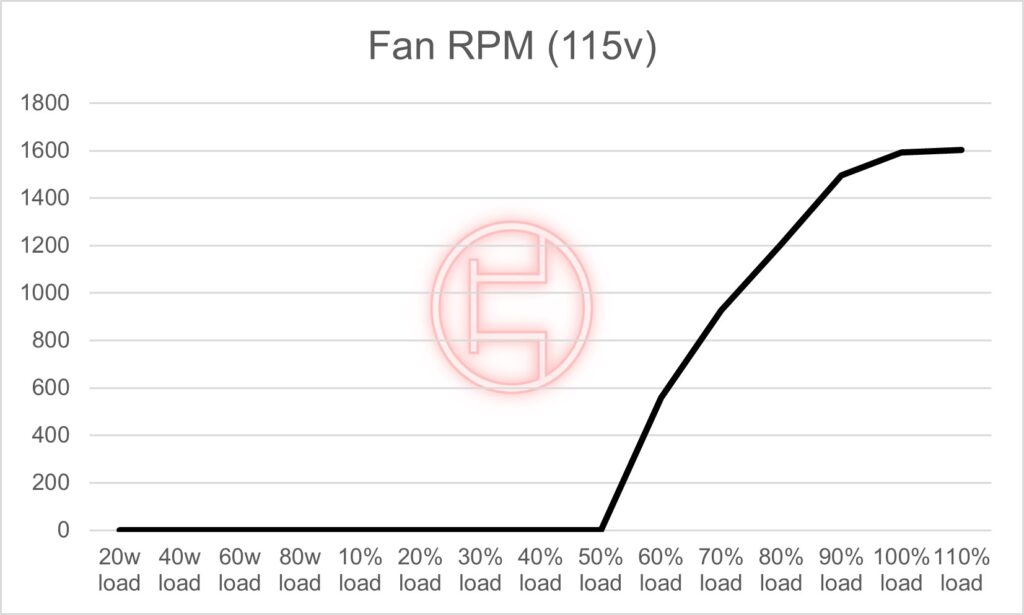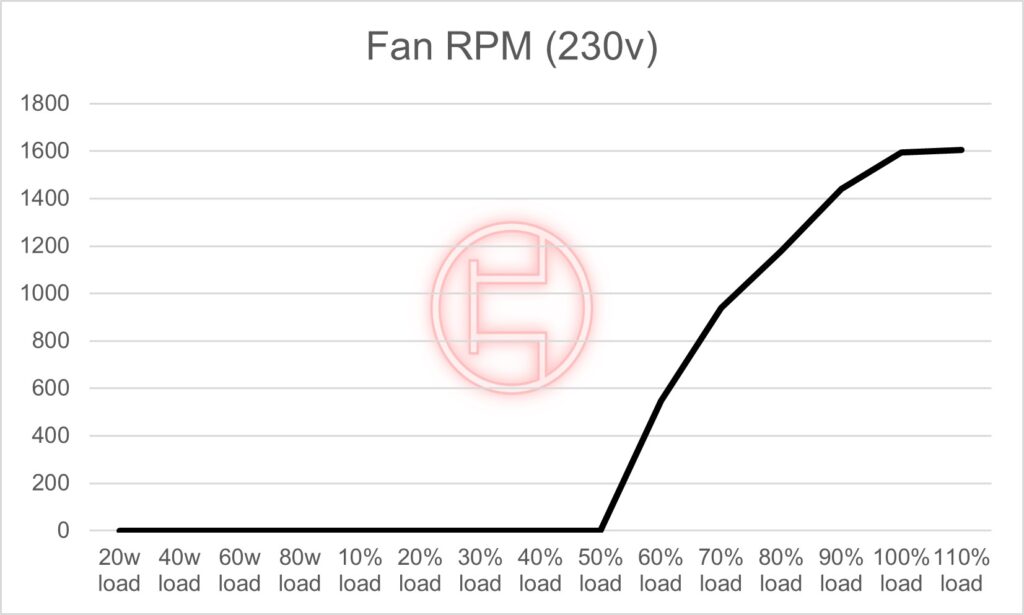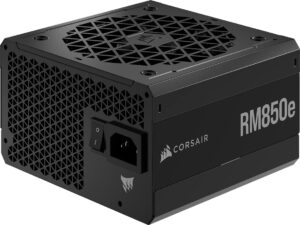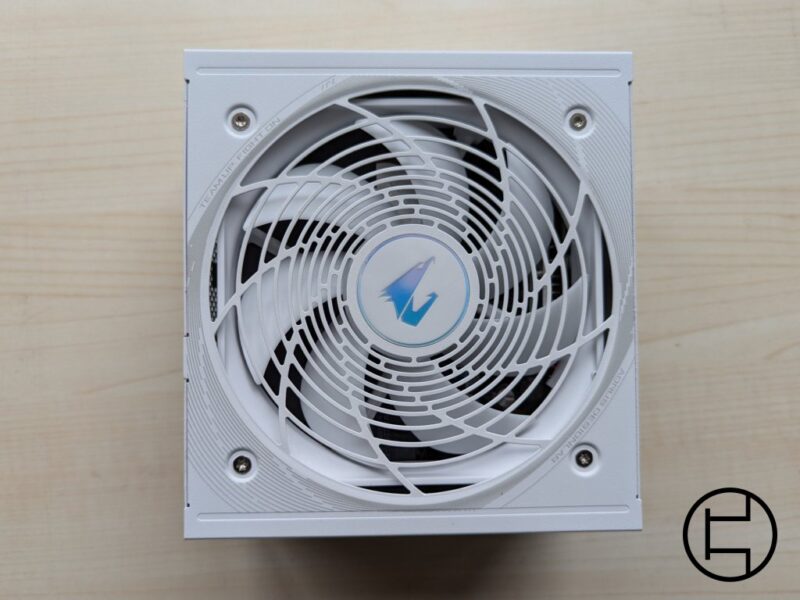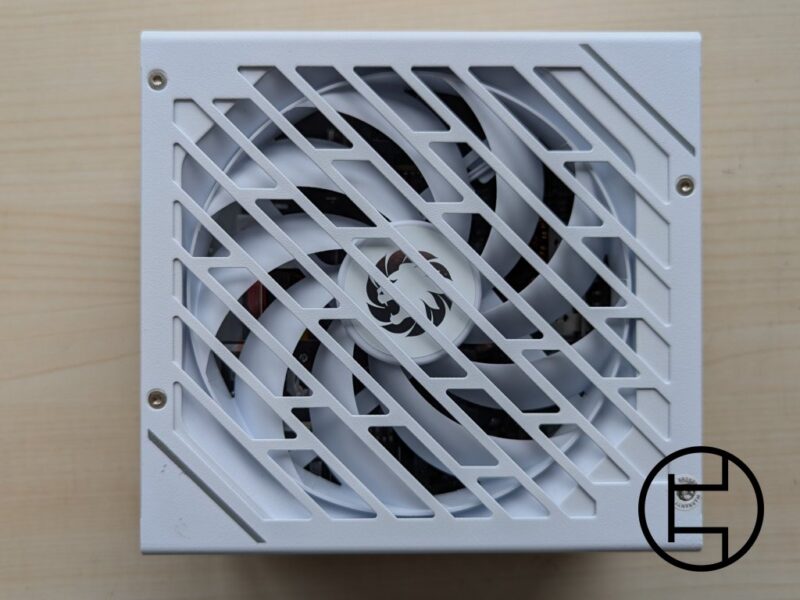Introduction
Starting out as Cooler Master’s first fully in-house designed lineup, the XG series is essentially the opposite approach of what the general market has been doing the past few years. We’ve seen high-wattage PSUs scale down to 130mm, even a few SFX-L units here and there. Instead, Cooler Master chose to make a physically larger unit to make it quieter. Today, we’re taking a look if their opposite approach paid off. Let’s get into this!
General Specifications
| Brand | Cooler Master |
| Model | XG Plus |
| Wattage | 850W |
| Introduction year | 2021 |
| Modularity | Full |
| Warranty | 10 Years |
Power Specifications
| 3.3V | 5V | 12V | 5VSB | -12V |
|---|---|---|---|---|
| 20A | 20A | 70.8A | 3.0A | 0.3A |
| 120W | 850W | 15W | 3.6W |
Cables
| Cable type | Cable Quantity | Connector Per Cable | Gauge |
|---|---|---|---|
| ATX 24 pin | 1 | 1 | 18 AWG |
| EPS 8 pin | 1 | 1 | 18 AWG |
| EPS 4+4 pin | 1 | 1 | 18 AWG |
| PCIe 6+2 pin | 3 | 2 | 16-18 AWG |
| SATA | 4 | 3 | 18 AWG |
| Peripheral 4 pin | 1 | 4 | 18 AWG |
| USB 10-pin | 1 | 1 |
Oh hey, 16 AWG on PCIe! Pleasant surprise to see more companies doing that. combined with that, it also uses HCS terminals, allowing for a higher limit of 13 amps instead of the regular 9 amps. Of course, I still would prefer to have separate PCIe 8 pin cables included, the higher wire gauge and high-quality terminals does make it a lot safer to daisy-chain.
The markings of CM-PSU and PCI-E/CPU/so on are a nice touch to both see where each plug should go and what PSU the unit is meant for. As a casual reminder, the PSU side pinout isn’t standardized, and because of that you can find a ton of different pinouts, even within a single company.
Otherwise, the included cables are about what you should expect of a modern 850w. Sufficient for everything from a NAS to a high-end gaming rig.
External
My first reaction to the unit came down to “what… is that exhaust?”. The XG850 Plus doesn’t use the regular hexagon or circle holes, nor does it use the triangle or square exhaust I’ve complained about before. We’ll have to see from results how well this works out… more about that later.
On one side, the XG850 Plus has kind of a screen. This is to display a Cooler Master logo, the model number and a readout of the fan RPM, power used and temperature of the unit. This, combined with the ARGB fan is what differentiates the XG plus from the regular XG. While the likes of Gigabyte and Asus have fully customizable screens instead of this rather limited one, they are also significantly higher in price.
Masterplus Software
The masterplus software offers two major features to the XG850. As a first, it gives you the option to log with an interval of one second or more. This allows you to actively log fan RPM, power usage and internal temperature and automatically export this to a TXT file.
The second of course is the RGB and the screen control. You can set a total of seven pre-set effects and a custom mode giving you a total of eight individually controllable RGB zones on the fan and a single one on the screen. While it would’ve been nice to color individual sections or even letters of the screen, this should make it possible to make quite a few nice effects with it… or turn it off when you get annoyed by it.
Overall, not the most impressive setup I’ve seen, considering Corsair also allows fan control and custom multirail setups through their iCue software on i-series PSUs, it’s not underwhelming either.
You can download the Masterplus software from Cooler Master’s site here.
Protections
| OPP | EM8569C |
| OCP | CM6901T6X, APW7159C |
| OTP | APW7159C |
| UVP | IN1S315I, APW7159C |
| OVP | IN1S315I, CM6500UNX, EM8569C, APW7159C |
| SCP | IN1S315I |
| MOV | Yes |
Hm… more protections integrated into the DC-DC controller than the supervisor IC… that’s new. But hey, not an issue at all. The XG850 Plus has the protection set I expect at this price, nothing to complain.
Parts Breakdown+Internal
| OEM | Xin Hui Yuan/Fusion Power |
| Platform | Custom |
| Input Voltage | 100-240VAC |
| Primary Converter | APFC Full Bridge LLC |
| Rectifier | Synchronous Rectification |
| Regulator | DC-DC |
| Fan | DF1352512FDHN (12V, 0.60A) |
| Bearing | Fluid Dynamic |
| PCB Type | Double Sided |
| Bulk Capacitor(s) | 1x Nippon Chemicon KMZ (450V, 680uf, 105c) |
| Bridge Rectifiers | 2x MCC GBU15KL (800V, 15A @ 100°C) |
| APFC MOSFETs | 2x NCE Power NCE65TF099 (650V, 24A @ 100c) |
| APFC Boost Diode | 1x Panjit CDP0865G1 |
| PFC Controller | Champion CM6500UNX |
| LLC Resonant Controller | Champion CM6901T6X |
| Main Switches | 4x NCE Power NCE65TF130 (650V, 18A @ 100c) |
| 12v MOSFETs | 4x Infineon BSC010N04LS (40V, 178A @ 100°C) |
| DC-DC Converters | 2x Excelliance MOS EMB04N03A, 2x Excelliance MOS EMB07N03 |
| DC-DC Controller | ANPEC APW7159C |
| Supervisor IC | INFSitronix IN1S313I-SAG |
| Standby PWM Controller | Excelliance MOS EM8569C |
Checks notes… Wait, this is XHY? Really? Impressive. XHY (commonly known as Fusion Power) is an OEM normally used for more budget-oriented designs like Cooler Master’s own MWE gold series, but has seemingly made some major upgrades recently considering they’re suddenly producing higher end offerings like the Cougar Polar series. I was expecting to find some soldering errors or alike but… nothing.
The bulk capacitor is a (pretty expensive) Nippon Chemicon KMZ, rated for 450V instead of the usual 400V. While there’s a shortage on these, it’s a really nice thing to have in higher end units, and while I don’t care about Japanese capacitors as a whole… it’s damn nice to see a 450V capacitor used.
Normally, I’d see the 12V MOSFETs below the PCB, but instead Cooler Master chose to put them on small daughter board on top.
Outside of that, I really like the heatsinks on this thing, the part choice is what you should expect, maybe even above of what a unit of this class should have. And while it does look rather empty, it does allow more surface area, allowing it to be cooler. Outside of it taking me the removal of 5 gooped up wires to open it, I have really nothing to complain about.
Electrical Performance
The following results are by third party PSU lab Cybenetics. The results shown are based off the XG850 (non-plus) Platinum report published on 30-08-2021.
Graphs
Test Equipment
| Electronic Loads | Chroma 63601-5 x4 |
| Chroma 63600-2 x2 | |
| 63640-80-80 x20 | |
| 63610-80-20 x2 | |
| AC Sources | Chroma 6530 |
| Keysight AC6804B | |
| Power Analyzers | N4L PPA1530 x2 |
| Sound Analyzer | Bruel & Kjaer 2270 G4 |
| Microphone | Bruel & Kjaer Type 4955-A |
| Data Loggers Picoscope TC-08 x2 | Labjack U3-HV x2 |
| Tachometer | UNI-T UT372 x2 |
| Digital Multimeter | Keysight U1273AX |
| Fluke 289 | |
| Keithley 2015 - THD | |
| UPS | CyberPower OLS3000E 3kVA x2 |
| Transformer | 3kVA x2 |
Overall (115v)
| Average efficiency | 90,187% |
| Efficiency at 2% load | 69,752% |
| Average efficiency 5VSB | 82,128% |
| Standby power consumption (W) | 0,0476787 |
| Average PF | 0,983 |
| Average noise output | 26,43 DB |
| Efficiency rating (ETA) | Platinum |
| Noise rating (LAMBDA) | A- |
Overall (230v)
| Average efficiency | 91,887% |
| Average efficiency 5VSB | 81,459% |
| Standby power consumption (W) | 0,0868279 |
| Average PF | 0,941 |
| Average noise output | 27,01 DB |
| Efficiency rating (ETA) | Platinum |
| Noise rating (LAMBDA) | A- |
Efficiency (115v)
| Load (115v) | Efficiency | AC (Watts) | DC (Watts) |
|---|---|---|---|
| 20w load | 72,174% | 27,701 | 19,993 |
| 40w load | 82,362% | 48,560 | 39,995 |
| 60w load | 86,365% | 69,468 | 59,996 |
| 80w load | 88,302% | 90,528 | 79,938 |
| 10% load | 88,292% | 96,272 | 85,000 |
| 20% load | 91,363% | 185,992 | 169,927 |
| 30% load | 91,964% | 277,204 | 254,927 |
| 40% load | 92,081% | 369,244 | 340,005 |
| 50% load | 91,731% | 463,222 | 424,920 |
| 60% load | 91,164% | 558,818 | 509,441 |
| 70% load | 90,583% | 656,588 | 594,756 |
| 80% load | 89,849% | 756,351 | 679,575 |
| 90% load | 89,306% | 856,585 | 764,985 |
| 100% load | 88,494% | 960,314 | 849,820 |
| 110% load | 87,621% | 1066,423 | 934,406 |
| Crossload 1 | 84,048% | 120,511 | 101,287 |
| Crossload 2 | 80,815% | 125,466 | 101,395 |
| Crossload 3 | 76,674% | 87,875 | 67,377 |
| Crossload 4 | 89,365% | 950,666 | 849,562 |
Efficiency (230v)
| Load (230v) | Efficiency | AC (Watts) | DC (Watts) |
|---|---|---|---|
| 20w load | 72,985% | 27,392 | 19,992 |
| 40w load | 82,659% | 48,383 | 39,993 |
| 60w load | 86,763% | 69,147 | 59,994 |
| 80w load | 88,987% | 89,831 | 79,938 |
| 10% load | 88,931% | 95,576 | 84,997 |
| 20% load | 92,341% | 184,021 | 169,926 |
| 30% load | 93,308% | 273,208 | 254,924 |
| 40% load | 93,621% | 363,168 | 340,002 |
| 50% load | 93,486% | 454,454 | 424,849 |
| 60% load | 93,145% | 546,894 | 509,402 |
| 70% load | 92,782% | 640,973 | 594,706 |
| 80% load | 92,309% | 736,138 | 679,524 |
| 90% load | 91,859% | 832,739 | 764,942 |
| 100% load | 91,342% | 930,307 | 849,763 |
| 110% load | 90,769% | 1029,353 | 934,338 |
| Crossload 1 | 85,067% | 119,061 | 101,282 |
| Crossload 2 | 81,734% | 124,048 | 101,39 |
| Crossload 3 | 77,377% | 87,072 | 67,374 |
| Crossload 4 | 92,063% | 922,741 | 849,507 |
Voltage Regulation (115v)
| Load (115v) | 12V (voltage) | 5V (voltage) | 3.3V (voltage) | 5VSB (voltage) |
|---|---|---|---|---|
| 20w load | 12.030V | 5.063V | 3.327V | 5.115V |
| 40w load | 12.030V | 5.062V | 3.327V | 5.111V |
| 60w load | 12.030V | 5.061V | 3.326V | 5.107V |
| 80w load | 12.029V | 5.061V | 3.329V | 5.103V |
| 10% load | 12.029V | 5.06V | 3.33V | 5.09V |
| 20% load | 12.028V | 5.059V | 3.328V | 5.079V |
| 30% load | 12.027V | 5.057V | 3.327V | 5.069V |
| 40% load | 12.025V | 5.055V | 3.326V | 5.058V |
| 50% load | 12.024V | 5.053V | 3.324V | 5.047V |
| 60% load | 12.022V | 5.051V | 3.322V | 5.035V |
| 70% load | 12.021V | 5.049V | 3.305V | 5.024V |
| 80% load | 12.019V | 5.047V | 3.256V | 5.014V |
| 90% load | 12.017V | 5.047V | 3.319V | 5.006V |
| 100% load | 12.015V | 5.045V | 3.317V | 4.983V |
| 110% load | 12.013V | 5.043V | 3.316V | 4.977V |
| Crossload 1 | 12.030V | 5.052V | 3.323V | 5.108V |
| Crossload 2 | 12.032V | 5.048V | 3.32V | 5.112V |
| Crossload 3 | 12.030V | 5.042V | 3.321V | 5.11V |
| Crossload 4 | 12.017V | 5.049V | 3.321V | 5.07V |
Voltage Regulation (230v)
| Load (230v) | 12V (voltage) | 5V (voltage) | 3.3V (voltage) | 5VSB (voltage) |
|---|---|---|---|---|
| 20w load | 12.031V | 5.062V | 3.332V | 5.115V |
| 40w load | 12.030V | 5.062V | 3.331V | 5.111V |
| 60w load | 12.030V | 5.061V | 3.331V | 5.107V |
| 80w load | 12.030V | 5.06V | 3.33V | 5.103V |
| 10% load | 12.029V | 5.059V | 3.33V | 5.09V |
| 20% load | 12.028V | 5.058V | 3.328V | 5.079V |
| 30% load | 12.026V | 5.057V | 3.327V | 5.068V |
| 40% load | 12.025V | 5.055V | 3.326V | 5.058V |
| 50% load | 12.023V | 5.052V | 3.325V | 5.047V |
| 60% load | 12.022V | 5.052V | 3.323V | 5.035V |
| 70% load | 12.020V | 5.05V | 3.322V | 5.023V |
| 80% load | 12.018V | 5.048V | 3.32V | 5.014V |
| 90% load | 12.016V | 5.047V | 3.319V | 5.006V |
| 100% load | 12.014V | 5.045V | 3.318V | 4.984V |
| 110% load | 12.012V | 5.043V | 3.316V | 4.978V |
| Crossload 1 | 12.029V | 5.051V | 3.323V | 5.108V |
| Crossload 2 | 12.031V | 5.048V | 3.321V | 5.112V |
| Crossload 3 | 12.030V | 5.041V | 3.322V | 5.11V |
| Crossload 4 | 12.018V | 5.048V | 3.321V | 5.071V |
Ripple (115v)
| Test | 12V | 5V | 3.3V | 5VSB | Pass/Fail |
|---|---|---|---|---|---|
| 10% Load | 9.55mV | 7.32mV | 8.75mV | 8.60mV | Pass |
| 20% Load | 12.53mV | 7.68mV | 8.95mV | 10.07mV | Pass |
| 30% Load | 13.80mV | 8.49mV | 9.96mV | 12.55mV | Pass |
| 40% Load | 12.81mV | 8.79mV | 9.91mV | 11.33mV | Pass |
| 50% Load | 13.77mV | 9.56mV | 10.92mV | 12.04mV | Pass |
| 60% Load | 15.74mV | 11.23mV | 11.63mV | 13.81mV | Pass |
| 70% Load | 16.25mV | 11.33mV | 12.64mV | 15.99mV | Pass |
| 80% Load | 17.16mV | 11.69mV | 13.95mV | 17.56mV | Pass |
| 90% Load | 17.67mV | 12.75mV | 13.19mV | 16.45mV | Pass |
| 100% Load | 27.19mV | 15.77mV | 16.58mV | 20.24mV | Pass |
| 110% Load | 29.49mV | 16.84mV | 18.04mV | 22.27mV | Pass |
| Crossload1 | 18.51mV | 13.92mV | 12.78mV | 13.06mV | Pass |
| Crossload2 | 14.08mV | 11.94mV | 7.08mV | 11.89mV | Pass |
| Crossload3 | 12.96mV | 10.57mV | 15.57mV | 10.37mV | Pass |
| Crossload4 | 26.40mV | 13.09mV | 14.83mV | 17.95mV | Pass |
Ripple (230v)
| Test | 12V | 5V | 3.3V | 5VSB | Pass/Fail |
|---|---|---|---|---|---|
| 10% Load | 10.76mV | 7.93mV | 10.16mV | 11.23mV | Pass |
| 20% Load | 14.26mV | 8.03mV | 9.20mV | 9.97mV | Pass |
| 30% Load | 15.27mV | 8.74mV | 9.66mV | 11.13mV | Pass |
| 40% Load | 12.33mV | 9.35mV | 10.46mV | 12.04mV | Pass |
| 50% Load | 13.06mV | 10.17mV | 10.36mV | 10.98mV | Pass |
| 60% Load | 14.13mV | 9.76mV | 10.82mV | 12.04mV | Pass |
| 70% Load | 14.94mV | 10.52mV | 11.17mV | 12.30mV | Pass |
| 80% Load | 16.71mV | 11.38mV | 12.89mV | 12.85mV | Pass |
| 90% Load | 17.47mV | 11.89mV | 12.44mV | 12.96mV | Pass |
| 100% Load | 25.42mV | 14.82mV | 15.25mV | 15.37mV | Pass |
| 110% Load | 27.63mV | 15.85mV | 16.26mV | 15.77mV | Pass |
| Crossload1 | 17.67mV | 12.71mV | 12.86mV | 12.16mV | Pass |
| Crossload2 | 13.21mV | 12.15mV | 8.19mV | 12.90mV | Pass |
| Crossload3 | 13.67mV | 11.03mV | 15.98mV | 11.84mV | Pass |
| Crossload4 | 27.15mV | 11.82mV | 13.53mV | 15.17mV | Pass |
Fan Speed/Noise (115v)
| Load (115v) | RPM | Noise (DBa) | Temperature in | Temperature out |
|---|---|---|---|---|
| 20w load | 0 | <6 | 37.03°C | 40.24°C |
| 40w load | 0 | <6 | 37.91°C | 41.51°C |
| 60w load | 0 | <6 | 38.89°C | 42.89°C |
| 80w load | 0 | <6 | 39.16°C | 43.76°C |
| 10% load | 0 | <6 | 39.65°C | 44.65°C |
| 20% load | 0 | <6 | 40.3°C | 45.82°C |
| 30% load | 0 | <6 | 40.87°C | 46.87°C |
| 40% load | 0 | <6 | 41.38°C | 47.88°C |
| 50% load | 0 | <6 | 41.56°C | 48.56°C |
| 60% load | 559 | 12,8 | 41.85°C | 49.38°C |
| 70% load | 927 | 29,1 | 42.28°C | 50.13°C |
| 80% load | 1207 | 36,8 | 43.72°C | 52.12°C |
| 90% load | 1495 | 42,3 | 43.9°C | 53.02°C |
| 100% load | 1592 | 44,1 | 44.68°C | 54.88°C |
| 110% load | 1603 | 44,2 | 46.79°C | 57.55°C |
| Crossload 1 | 0 | <6 | 42.01°C | 49.25°C |
| Crossload 2 | 0 | <6 | 43.12°C | 51.26°C |
| Crossload 3 | 0 | <6 | 44.52°C | 53.52°C |
| Crossload 4 | 1235 | 37,6 | 45.02°C | 55.29°C |
Note: the Plus version is always spinning, unlike the regular XG. So the fancurve might be slightly louder overall, but not noticeably
Fan Speed/Noise (230v)
| Load (230v) | RPM | Noise (DBa) | Temperature in | Temperature out |
|---|---|---|---|---|
| 20w load | 0 | <6 | 36.83°C | 40.03°C |
| 40w load | 0 | <6 | 36.91°C | 40.71°C |
| 60w load | 0 | <6 | 37.75°C | 42.25°C |
| 80w load | 0 | <6 | 38.38°C | 43.38°C |
| 10% load | 0 | <6 | 40.33°C | 45.83°C |
| 20% load | 0 | <6 | 40.88°C | 46.72°C |
| 30% load | 0 | <6 | 41.77°C | 48.21°C |
| 40% load | 0 | <6 | 42.28°C | 49.06°C |
| 50% load | 0 | <6 | 42.56°C | 49.86°C |
| 60% load | 548 | 12,2 | 42.78°C | 50.84°C |
| 70% load | 939 | 29,6 | 43.34°C | 51.95°C |
| 80% load | 1180 | 36,1 | 43.85°C | 52.81°C |
| 90% load | 1440 | 41,3 | 44.74°C | 54.11°C |
| 100% load | 1595 | 44,1 | 45.71°C | 55.64°C |
| 110% load | 1604 | 44,3 | 46.77°C | 57.66°C |
| Crossload 1 | 0 | <6 | 42.26°C | 49.09°C |
| Crossload 2 | 0 | <6 | 43.56°C | 50.71°C |
| Crossload 3 | 0 | <6 | 44.93°C | 53.25°C |
| Crossload 4 | 1576 | <6 | 45.89°C | 56.21°C |
Note: the Plus version is always spinning, unlike the regular XG. So the fancurve might be slightly louder overall, but not noticeably
Hold-up Time (230v)
| Hold-up time (ms) | 26,1 |
| AC loss to PWR-OK hold up time (ms) | 22 |
| PWR_OK inactive to DC loss delay (ms) | 4,1 |
Conclusion
Honestly, the XG850 plus impressed me. The build quality of it is amazing, the part choice makes total sense, even going above others in some cases with for example a 450V bulk capacitor and a really nice DC-DC controller.
However, my review won’t be fully without complaints. The screen has a limited amount of use and I would’ve liked to have individual PCIe cables included mainly for cable management sake. It’s also quite a bit more expensive than the regular XG850, making that generally a better option for most people.
But if what you’re looking for is a high-end RGB PSU with digital functionality, the XG850 Plus should definitely be in your consideration.
Cooler Master XG850 Plus
Buy XG850 Plus
- Great part choice
- Impressive build quality
- Quiet
- Efficient
- ARGB
- Software integration
- Expensive
- Limited use to the screen
Alternatives
Silverstone Hela 850R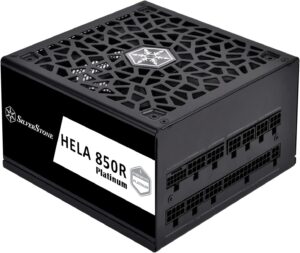
Buy Hela 850R
- Slightly more quiet
- ATX 3.0 compatible
- Included 12VHPWR connector
- Not yet widely available
- No ARGB or screen
Cooler Master XG850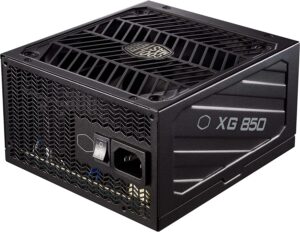
Buy XG850
- Significantly cheaper
- Same part choices
- No screen or ARGB
Fractal Design Ion 2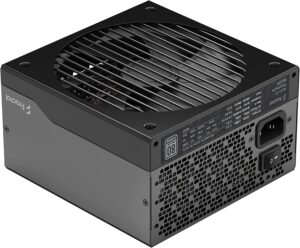
Buy Ion 2 860w
- Generally cheaper than XG850
- Fixed fan curve compared to Ion+
- Worse part choice
- Significantly cheaper
- Same HCS terminals and 16 AWG wires used
- Less efficient
- Worse part choice
- RMe isn't widely available yet
- Significantly cheaper
- Same HCS terminals and 16 AWG wires used
- White and black options
- Less efficient
- Worse part choice
Adata XPG Core Reactor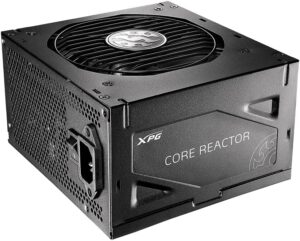
Buy XPG Core Reactor 850w
- Significantly cheaper
- Same HCS terminals and 16 AWG wires used
- Less efficient
- Worse part choice
Thermaltake PF1 ARGB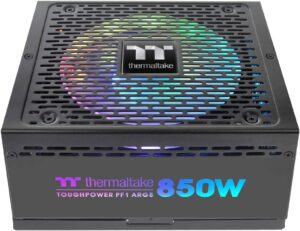
Buy PF1 ARGB
- Similar build quality
- Well-covered base platform
- ARGB
- No screen
- Expensive
Thermaltake GF1 ARGB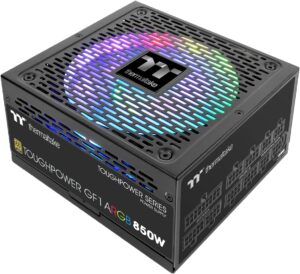
Buy GF1 ARGB 850w
- Significantly cheaper
- ARGB
- No screen
- Less efficient
- Worse part choice
Superflower Leadex III ARGB
Buy Leadex III ARGB 850W
- Significantly cheaper
- ARGB
- Low AWG wires on second PCIe connector
- No screen
- Less efficient
- Worse part choice

